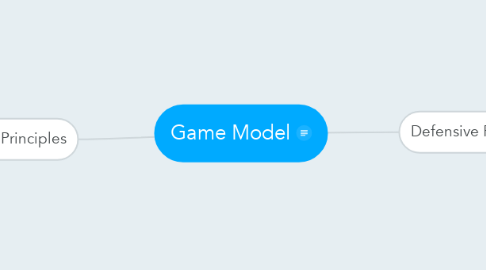
1. Offensive Principles
1.1. Offensive Transition (BPO > BP)
1.1.1. Quick, aggressive mental change of attitude from defensive to offensive
1.1.2. Quickly occupy the three field channels
1.1.3. On recovering possession, get it to the central channel (10 or 9) as quickly as possible
1.1.4. When time and space allows, run with the ball to attract opponents and leave teammates unmarked
1.1.5. Take advantage of the space behind the last line of the opponent's defence
1.2. Offensive Organisation (BP)
1.2.1. 1st Build Phase - Offensive game build-up
1.2.1.1. Good positional balance
1.2.1.2. Defensive line of 3
1.2.1.3. Keeper with excellent feet
1.2.1.4. Pass to attract
1.2.1.5. Offensive unity
1.2.2. 2nd Build Phase - Creation of finishing situations
1.2.2.1. Positional exchanges without losing functionality
1.2.2.2. Wingers and outside backs in different lanes
1.2.2.3. Positional organisation that permits a relationship between the players
1.2.2.4. Drive the attack to the favourable progression zones
1.2.3. 3rd Build Phase - Finishing the attacking actions efficiently
1.2.3.1. Crossing under favourable conditions
1.2.3.2. Positioning in the effective finishing zones
1.3. Key Principles
1.3.1. Big field
1.3.2. Playing direct
2. Defensive Principles
2.1. Defensive Transition (BP > BPO)
2.1.1. Quick, aggressive mental attitude change from offence to defence
2.1.2. Compact the team creating various depth lines
2.1.3. Close the spaces in the interior of the team's defensive block
2.1.4. Prevent penetrations behind the last line of defence
2.2. Defensive Organisation (BPO)
2.2.1. 1st Defensive Phase - Prevent the opponent building an attack
2.2.1.1. Centre circle as a reference for the defensive block organisation
2.2.1.2. Prevent penetration through the interior defensive block
2.2.1.3. Intense pressure in the lateral channels
2.2.2. 2nd Defensive Phase - Prevent the creation of finishing situations
2.2.2.1. Deploy the team in various lines both deep and wide
2.2.2.2. Sectors near each other to close the spaces between the lines
2.2.2.3. Strong side/weak side shifting
2.2.2.4. Push up field, reduce spaces
2.2.3. 3rd Defensive Phase - Prevent a successful finish
2.2.3.1. Prioritise defensive depth
2.2.3.2. Pressure the ball carrier with a defensive coverage of 3
2.2.3.3. Occupy by anticipation the privileged finishing zones
2.2.3.4. Win the 2nd balls
2.3. Key Principles
2.3.1. Force the opponent to play long
2.3.2. Prevent being beaten (1v1)
